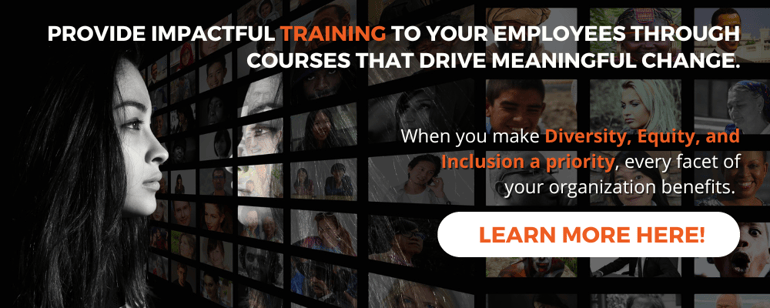While today's workforce is shaped by laws and regulations preventing discrimination, there remains a pervasive issue that continues to impact employees across generations: ageism.
Age discrimination remains a significant and costly problem for workers, their families and our economy.
~ Equal Employment Opportunity Commission
This form of discrimination, based solely on a person's age, has far-reaching consequences in the workplace. Ageism can manifest in various ways, from subtle comments to overt exclusion from opportunities, impacting workers young and old alike.
The effects of age discrimination have impacts throughout organizations. For older workers, it might mean being passed over for promotions or feeling pressured to retire. Younger employees might find their ideas dismissed or struggle to gain respect from older colleagues. In both cases, the result is a work environment where individuals cannot fully contribute their skills and experiences.
With multiple generations working side by side more frequently today, addressing ageism is not just a matter of fairness—it's a business imperative. Creating an age-inclusive workplace fosters a culture of respect, leverages the strengths of all age groups, and ultimately drives organizational success.
The Prevalence of Ageism in the Workplace
Ageism is a pervasive issue in workplaces, affecting employees across various age groups but particularly impacting older workers. Recent studies and surveys have shed light on the extent of this problem:
- A 2023 study by the Society for Human Resource Management (SHRM) found that nearly one-third (30%) of U.S. workers report have felt unfairly treated due to their age at some point in their career. Even more concerning, 72% of these workers admitted that such mistreatment made them consider quitting their jobs.
- A 2018 survey conducted by AARP found that "16 percent of respondents believe they did not get a job they applied for, 12 percent said they had been passed over for a promotion, and 7 percent said they had been laid off, fired or forced out of a job — all because of age discrimination."
- In a study of nearly 1900 employers by Transamerica, 56% of respondents answered, "it depends" when queried about the age at which someone was "too old to hire" or "too old to work." However, among those who did give a specific number, 62 was deemed too old to work, and 58 too old to hire.
- A 2022 study by Live Career revealed that just 16% of employees reported never experiencing or seeing age discrimination in the workplace.
- Ageism doesn't only affect older workers. Younger workers frequently report experiencing so-called "reverse ageism" when their opinions are discounted or they are not given challenging opportunities because of their relative youth.

Recognizing Ageism in Action
Ageism in the workplace can be both overt and subtle, making it challenging to identify and address. Understanding the various ways age discrimination manifests is crucial for both employees and employers. Common signs of ageism to watch out for:
hiring practices and job descriptions
Job postings may use language that favors certain age groups, such as "digital native" or "seasoned professional." Companies might show patterns of hiring predominantly younger or older employees, potentially overlooking qualified candidates from other age groups. Some companies ask for the full date of birth including the year on job applications.
Promotion and career development opportunities
Employees of certain age groups might receive more frequent promotions or access to challenging assignments. Professional development opportunities, including training and conferences, could be disproportionately offered to specific age demographics.
Social Exclusion and Workplace culture
Workplace social dynamics can sometimes exclude employees based on age. Team-building activities or after-work events might cater to specific age groups, potentially leaving others feeling isolated or disconnected from their colleagues.
age-related comments and jokes
Workplace humor targeting age-specific stereotypes can create an uncomfortable environment. Comments about retirement plans, technological aptitude, or generational traits, even if meant lightheartedly, may contribute to age-based tensions.
Performance evaluations and crticism
Evaluations and feedback might reflect age-related biases. Younger workers could face skepticism about their experience, while older employees might encounter assumptions about their adaptability or technological skills.
layoffs and terminations
Company restructuring or downsizing efforts may disproportionately affect certain age groups. This could manifest through targeted early retirement packages or a pattern of retaining employees within specific age ranges.
work assignments and responsibilities
The distribution of tasks and responsibilities might reflect age-based assumptions. Younger employees could be overlooked for leadership roles, while older workers might find their duties gradually reduced or less aligned with their skills and experience.
language and communication
Workplace communication may include age-specific terminology or references that reinforce generational stereotypes. Even well-intentioned comments about age can perpetuate biases and create divisions among employees.
technology and skill assumptions
Presumptions about technological proficiency or innovative thinking based on age can impact work assignments and team dynamics. Younger workers might be automatically associated with digital skills, while older employees' tech abilities may be underestimated.
Legal Landscape: Protections and Limitations
The Age Discrimination in Employment Act (ADEA) of 1967 is the primary federal law protecting workers aged 40 and older from age-based discrimination in all aspects of employment. However, its effectiveness has been impacted by subsequent Supreme Court rulings and inherent limitations.
Key points:
- The ADEA applies to employers with 20 or more employees, including state and local governments.
- The Older Workers Benefit Protection Act of 1990 amended the ADEA to specifically prohibit age discrimination in employee benefits.
- Supreme Court rulings have affected the ADEA's implementation:
- In Gross v. FBL Financial Services, Inc. (2009), the Court ruled that plaintiffs must prove age was the "but-for" cause of the adverse employment action, making age discrimination cases more challenging to win.
- The Hazen Paper Co. v. Biggins (1993) decision allowed employers to make decisions based on factors correlated with age, like pension status, without violating the ADEA.Supreme Court rulings have affected the ADEA's implementation:
- Many states have their own age discrimination laws, some of which protect younger workers or apply to smaller employers.
- The proposed Protecting Older Workers Against Discrimination Act (POWADA) aims to lower the burden of proof in age discrimination cases, but it has not yet been enacted.
Despite these protections, age discrimination remains underreported. According to AARP, only 3% of older employees who experience age discrimination file formal complaints. This underreporting may be due to fear of retaliation, lack of awareness about legal rights, or skepticism about the effectiveness of legal recourse.
To create truly age-inclusive workplaces, employers must go beyond legal compliance and proactively address ageism through comprehensive policies, training, and cultural change initiatives.
Strategies for Combating Ageism
Creating an age-inclusive workplace requires a multifaceted approach that addresses both systemic and cultural aspects of ageism. Here are some effective strategies:
work with an eap to develop age-inclusive policies
An Employee Assistance Program (EAP) can be instrumental in crafting age-inclusive workplace policies. By collaborating with an EAP, employers can gain access to expert advice and resources tailored to fostering an inclusive environment for all age groups. EAPs can also provide training sessions to educate staff on recognizing and combating ageism and offer support services for employees who feel they have been subjected to discrimination.
education and training
Implementing age diversity training can help raise awareness about ageism and its impact. Training should cover unconscious bias, the value of age diversity, and strategies for fostering an inclusive environment. Hiring age experts to conduct workshops and seminars can provide valuable insights and practical tools for combating ageism.policy implementation
Conducting age equity audits can help organizations identify and address age-related biases in their policies and practices. Developing and enforcing clear anti-discrimination policies that include age as a protected characteristic is essential. These policies should be communicated to all employees and integrated into the company's code of conduct.
fostering an inclusive culture
Promoting intergenerational collaboration can help break down age-related barriers and foster mutual respect. Encouraging age-diverse teams and mentorship programs can facilitate knowledge sharing and innovation. Creating a culture that values the contributions of all age groups involves setting expectations for zero tolerance towards age-based bias and discrimination.
rethinking recruitment and retention
Adopting age-neutral hiring practices is crucial for attracting a diverse talent pool. This includes using inclusive language in job postings, avoiding age-related questions during interviews, and focusing on skills and experience rather than age. Providing growth opportunities for employees of all ages, such as training, career development programs, and flexible work arrangements, can help retain valuable talent.
communication and language
Eliminating ageist language in the workplace is essential for creating an inclusive environment. This involves being mindful of the words and phrases used in everyday interactions, as well as in official communications and documents. Encouraging open dialogue about age-related issues can help address concerns and foster understanding among employees.
10 Benefits of an Age-Inclusive Workplace
Creating an age-inclusive workplace offers numerous benefits for organizations:
1. Enhanced creativity and Innovation
Diverse teams that include a range of ages bring different perspectives and experiences to the table. This diversity can lead to more creative problem-solving and innovative ideas. Older workers may offer valuable historical context and industry knowledge, while younger employees might bring fresh perspectives and new technological skills.
2. improved employee morale and retention
Employees who feel valued and respected, regardless of their age, are more likely to be engaged and committed to their work. An inclusive environment can boost morale, reduce turnover rates, and foster a sense of belonging among all age groups.
3. broader talent pool and diverse perspectives
By embracing age diversity, organizations can tap into a broader talent pool and benefit from the unique insights and skills that workers of all ages bring. This can enhance decision-making, improve customer relations, and drive business success.
4. knowledge transfer and mentorship
Age-inclusive workplaces facilitate the transfer of knowledge between generations. Experienced employees can mentor younger colleagues, while younger workers can reverse-mentor older employees on new technologies and trends. This cross-generational learning strengthens the overall skill set of the organization.
5. enhanced customer relations
A workforce that reflects the age diversity of the customer base can better understand and serve clients of all ages. This can lead to improved customer satisfaction and potentially open up new market opportunities.
6. improved adaptability and resilience
Organizations with age-diverse teams are often more adaptable to change and resilient in the face of challenges. The combination of fresh ideas and seasoned experience can help companies navigate complex business environments more effectively.
7. positive company reputation
Companies known for their age-inclusive practices often enjoy a positive reputation, which can attract top talent, customers, and investors. This can lead to a competitive advantage in the marketplace.
8. reduced legal risks
By proactively addressing ageism, companies can reduce the risk of age discrimination lawsuits and the associated costs and reputational damage.
9.increased productivity
When employees of all ages feel valued and included, overall productivity tends to increase. Age-inclusive workplaces often see higher levels of employee engagement and job satisfaction across all age groups.
10. long-term sustainability
As the workforce continues to age, companies that have already established age-inclusive practices will be better positioned to adapt to demographic shifts. This forward-thinking approach contributes to the long-term sustainability of the organization.
By recognizing and leveraging these benefits, organizations can create a more dynamic, productive, and innovative work environment that values the contributions of all employees, regardless of age.
Combating Ageism Makes for a Better Workplace
For the first time in history, there are five generations in the workplace - but the problems of age discrimination remain. Organizations need to proactively combat discrimination of all types, including ageism.
Companies that embrace and champion age diversity ultimately pave the way for a more equitable and forward-thinking future - and better results.
|
|||||||||||||||||||||||||||||||||||||||||||||||||||||||||||||||||||||||||||||||||||
When you partner with Ulliance, our Life Advisor Consultants are always just a phone call away to teach ways to enhance your work/life balance and increase your happiness. The Ulliance Life Advisor Employee Assistance Program can help employees and employers come closer to a state of total well-being.
Investing in the right EAP or Wellness Program to support your employees will help them and help you. Visit https://ulliance.com/ or call 866-648-8326.
The Ulliance Employee Assistance Program can address the
following issues:
• Stress about work or job performance
• Crisis in the workplace
• Conflict resolution at work or in one’s personal life
• Marital or relationship problems
• Child or elder care concerns
• Financial worries
• Mental health problems
• Alcohol/substance abuse
• Grief
• Interpersonal conflicts
• AND MORE!
Have some questions about our services? Book a quick meeting below!
References:
6 Signs of Ageism in the Workplace and How to Deal With It; Top Resume; Natalie Autenrieth https://www.topresume.com/career-advice/signs-of-ageism-in-the-workplace
Ageism in the Workplace, Statistics to Know; BuiltIn; Matthew Urwin
https://builtin.com/diversity-inclusion/ageism-in-the-workplace
New SHRM Research Details Age Discrimination in the Workplace; Society for Human Resources Management (SHRM)
https://www.shrm.org/about/press-room/new-shrm-research-details-age-discrimination-workplace
Older People and the Workplace | 2024 Report; Live Career; Nina Paczka https://www.livecareer.com/resources/careers/planning/older-workers
Workplace Age Discrimination Still Flourishes in America; AARP; Joe Kita, https://www.aarp.org/work/age-discrimination/still-thrives-in-america/


